If you’re planning a trip to Hawai‘i Volcanoes National Park on the Big Island of Hawai’i, witnessing the Hawai‘i volcano Kīlauea eruption is an unforgettable experience. Kīlauea is one of the world’s most active volcanoes, offering visitors a rare opportunity to see this event sacred to Native Hawaiians.
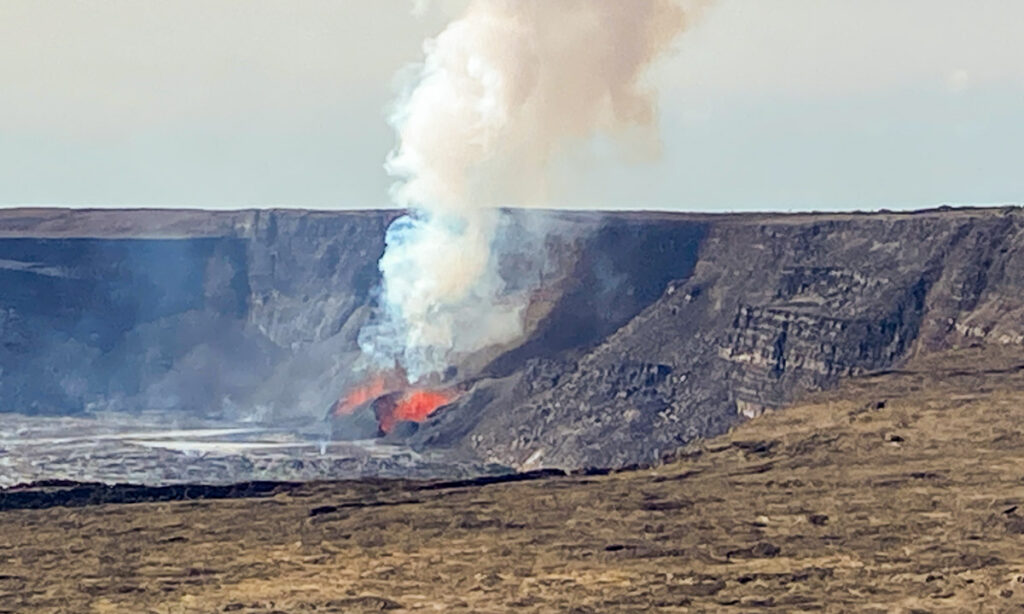
When I visited Hawai’i Volcanoes National Park in February of 2025, I was lucky enough to see episode eight of the most recent eruption. This was actually my second time seeing lava flowing from Kilauea, both being tremendous experiences. The national park can become very crowded during an eruption, and parking is a challenge. Below is a guide to how to see the Hawai’i volcano Kilauea erupting at Hawai’i Volcanoes National Park, including tips for parking, viewpoints, and timing.
Disclosure: Some of the links below may be affiliate links, meaning, at no cost to you, I will earn a commission if you click through and make a purchase.
A Brief History of Hawai‘i Volcanoes National Park
Hawai‘i Volcanoes National Park was established in 1916 to protect and showcase the unique volcanic landscapes of the Big Island. The park spans over 335,000 acres, encompassing two of the world’s most famous volcanoes: Mauna Loa, the largest volcano on Earth by volume (also a frequent answer to crossword clues, who knew), and Kīlauea, one of the most active in the world. Kīlauea has been erupting frequently for decades, shaping the island’s geography and playing a vital role in Hawaiian cultural and spiritual traditions.
Kīlauea is a shield volcano with shallow slopes, and the volcanic activity is in the Halemaʻumaʻu crater in the summit of the caldera. Most volcanic activity happens in this crater. However, in 2018 lava flowed from the internal “plumbing” out two rift zones on the southern and eastern edges, damaging roads, houses and neighborhoods.
Hawai’i Volcanoes National Park is located on the southeastern portion of the Big Island of Hawai’i near the town of Volcano. It is a 2 hour drive from Kona, or 30 minutes from Hilo. The park is open 24 hours a day. An entry permit is required when the park entry gates are open.
Other important volcanoes?
Mount Rainier, of course! If Tahoma erupts, we’re toast. In fact, Washington is home to many volcanoes in the Cascade Mountain Range. The more you know star.
Why Kīlauea Is Important
Kīlauea is deeply tied to Hawaiian mythology and history. In Hawaiian culture, Kīlauea is believed to be the home of Pele, the goddess of volcanoes and fire. This is a site important to many native Hawaiians, and worthy of respect when visiting.
While we were there, we attended a talk by one of the park rangers, who said that most of what we know about volcanology was learned from scientific research on the Kīlauea volcano.
While writing this post, I tried to find some information written by native Hawaiians on Pele. While I wasn’t able to find much via the Googles, I found a few interesting additional resources:
- The National Parks Site on Pele, the goddess of the volcano who makes Kīlauea her home
- Lecture notes from the University of Hawaii Hilo geology class circa 2008 on the legend of Pele! I would not be surprised to find an “under construction” gif on this site
- The original application to add the Kīlauea Crater to the National Register of Historic Places from the 1970s, absolutely written on a typewriter
How will I know if Kīlauea is erupting?
Hawai’i Volcanoes National Park (HVNP) is absolutely worth visiting even if the volcano is not actively erupting. The park has several hikes and sites that are open year round, and endemic flora and fauna not seen anywhere else in the world. The park becomes that much more special when there is an active eruption.
The best way to know if the volcano is erupting is to check the US Geological Survey’s website for Kīlauea. The USGS posts daily when an eruption is happening, and also publishes the current status of seismic activity and the tiltometer in the crater. Another immediate way is to check the Kīlauea’s live stream on Youtube. You’ll be able to see immediately if there is any activity. USGS and Hawaii Volcanoes National Park also usually post on Instagram when an eruption is happening, but in my experience it’s not immediate. The USGS Kīlauea page is the most up to date resource on the volcano.
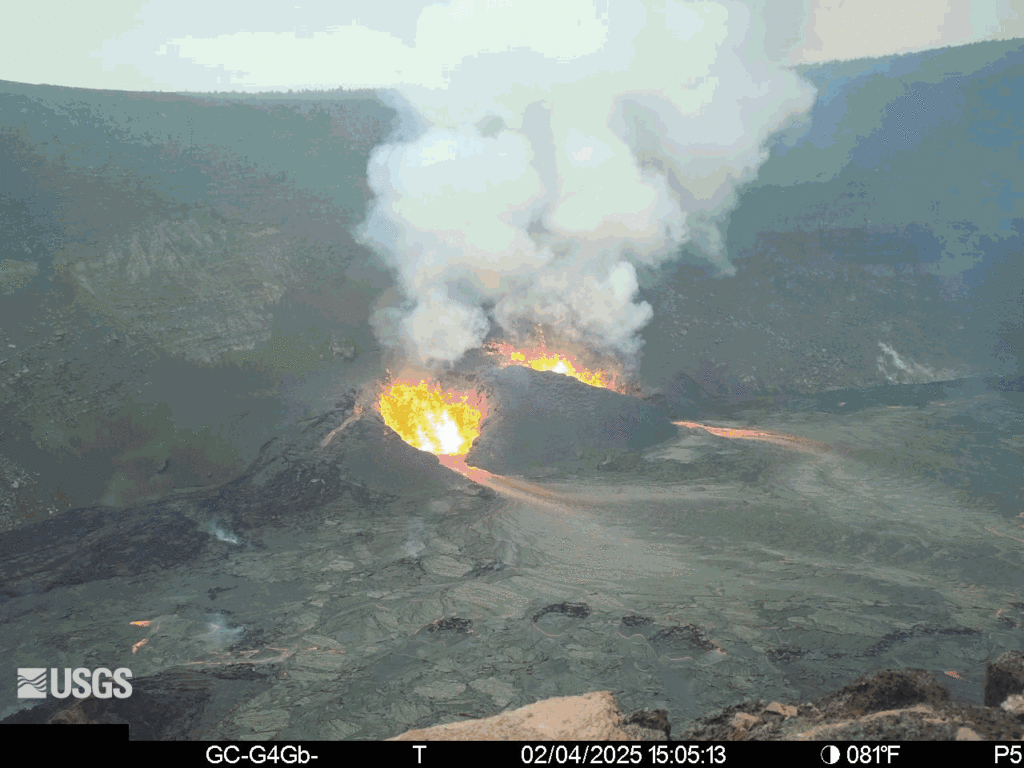
Where to Park to See the Kīlauea Eruption
Parking at Hawai’i Volcanoes National Park can be tough in the best of visits when the volcano is not erupting. It’s an absolute bear when it is erupting. HVNP has one visitor center with a small parking lot, a larger lot along the crater near viewing areas, and smaller lots sprinkled throughout the park. During busy times, park staff will block off lots and direct traffic elsewhere.
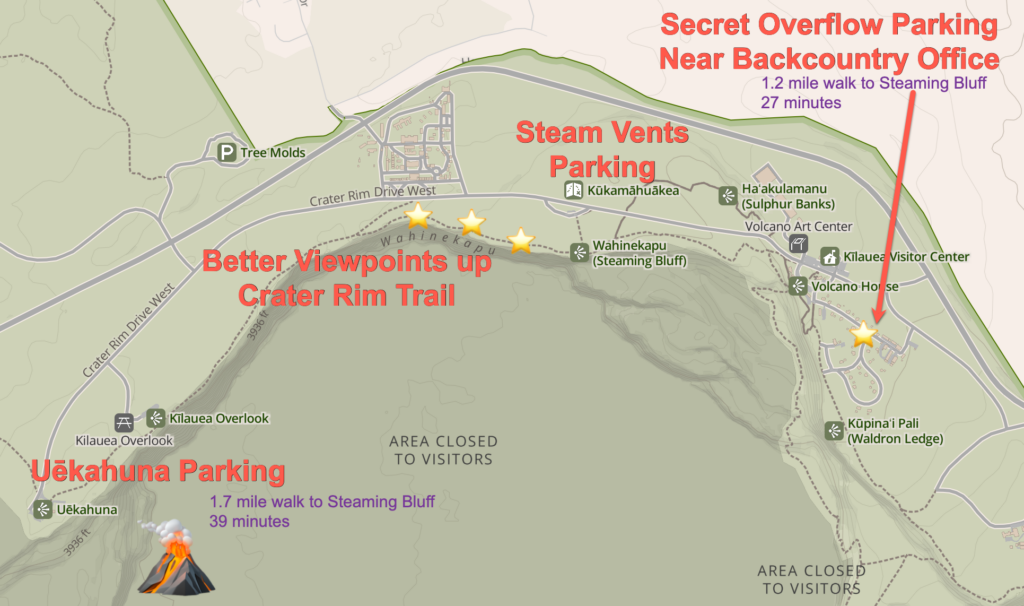
I made you a VERY professional map (above) to show some parking and viewpoint options to see the volcano, denoted by a 🌋.
1. Arrive early (or very, very late) to snag a spot at the Visitor Center or Steam Vents
The two best parking lots are at the main Kīlauea Visitor Center and the Steam Vents parking lots.
On our most recent visit, my sister and I arrived at 10am after our two hour drive from our hotel. We were able to get one of the last spots at Steam Vents. A bit later, cars were parked all along the roads. Tour buses begin to arrive by noon, filling up parking lots even more.
We left the park for good by 2:30pm and the parking lots were beginning to thin out. The park staff also open up bus parking in the main lot to passenger cars at 2pm for additional space.
The park is open 24 hours a day, so you can also arrive at the park at night to see the glow of the eruption against the night sky, known as the lavaglow. If you arrive at night, bring a flashlight, headlamp and reflective clothing for safety. Hawai’i gets *very* dark at night, which is why stargazing is so great here.
Goal: Arrive by 8:30am in the morning, or after 3pm
2. Park in Secret Overflow Lot near the Backcountry Permit Office
My friend AB told me about these lots, and as we passed them on our way out of the park they were not full. Enter the park and drive towards the Kilauea Visitor Center. At the stop sign just before the Visitor Center, turn left instead of going straight. You’ll go behind Volcano House and its lots towards the Backcountry Permit Office and Staff Buildings. There will be small overflow parking lots here.
These lots are a nine minute walk to the Visitor Center, or a 27 minute relatively flat walk to the Steaming Bluffs viewpoints.
3. Be okay with walking and park further away
If you don’t mind walking, you can get a parking spot slightly further away and walk to the Visitor Center and the viewing areas. By keeping your car in one spot you minimize the risk of not finding a spot at your next destination. Plus, you’ll see more of the park and see the eruption from different angles.
These lots include:
- Uēkahuna Parking Lot: 1.7 mile/39 minute walk to Steaming Bluffs viewpoint. Not a great viewpoint for the eruption, but you can hear it well from here!
- Kilauea Overlook Parking: just before Uēkahuna, 1.3 mile/27 minute walk
- Devastation Trail: A viewpoint until itself
Where to See the Kīlauea Eruption
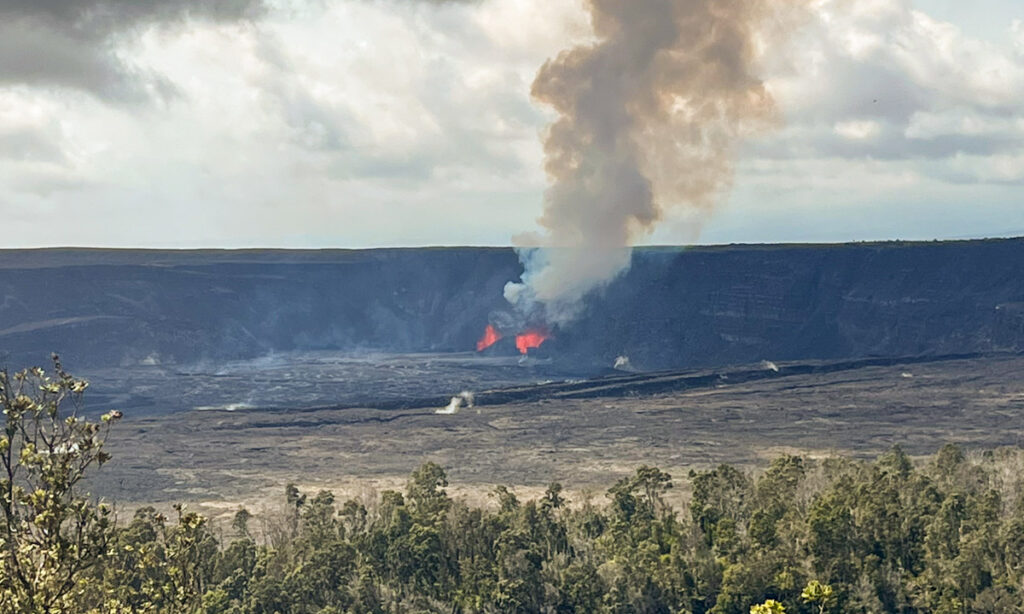
1. Volcano House hotel
The Volcano House hotel has an easily accessible view both indoors and out looking straight on to the Halema’uma’u Crater and the eruption. Rangers are often at this location to answer questions and share a closeup view via telescope. Volcano House also has a coffee shop, full restaurant and great gift shop. You can also stay the night there and be among the first to know if there is an eruption!
- Best parking: Visitor Center or Volcano House (both limited).
- How to get there: Park at Visitor Center or Volcano house and follow signs to Volcano House
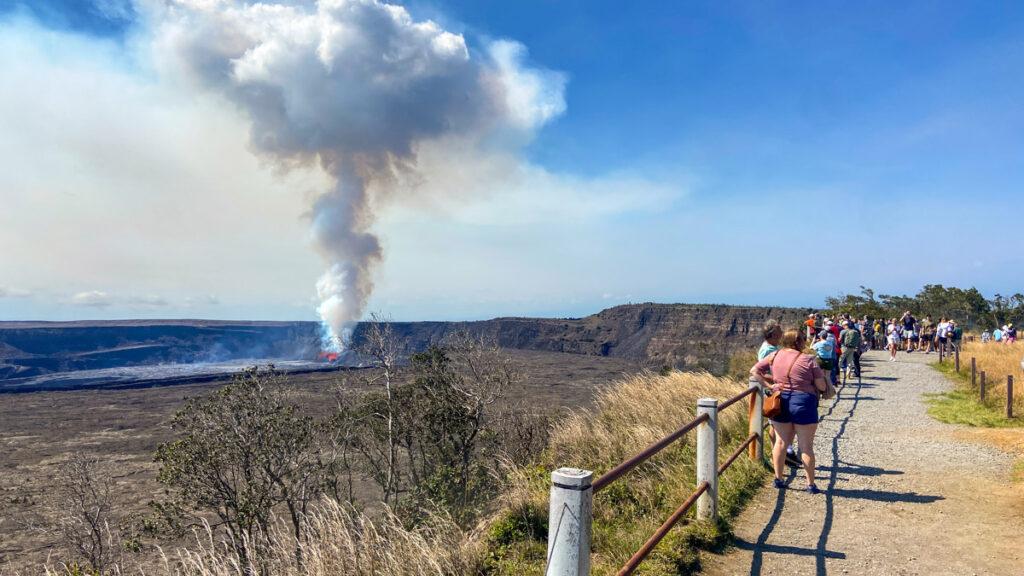
2. Wahinekapu/Steaming Bluffs Overlook and Viewpoints west
I thought the Wahinekapu/ Steaming Bluffs overlook area had the best viewpoints, as you’re viewing the crater from the side and can get a good sense of the scale of the eruption this way. This viewpoint can get crowded, but if you head west up the Crater Rim Trail (away from the Visitor Center, towards Uēkahuna), the crowds disperse and you’ll have the viewpoints to yourself. I made an Instagram reel showing the viewpoints.
- Best parking: Steam Vents parking.
- How to get there: Keep going past the Visitor Center to the large parking lot on the left.
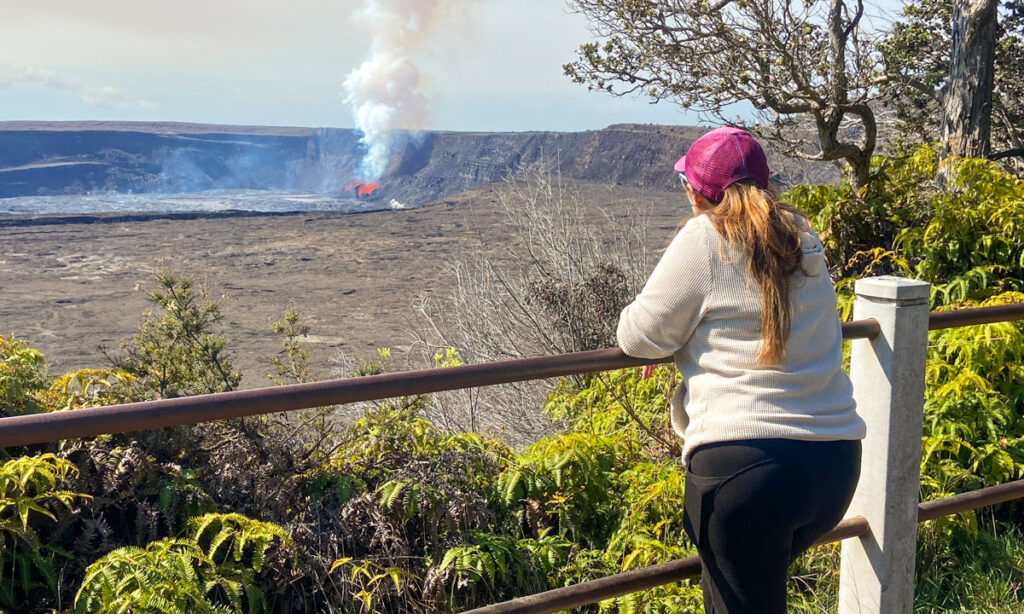
3. Halemaʻumaʻu Trail or Crater Rim Overlook
You have two additional options if you are near Volcano House or the Visitor Center. Follow the signs for “Eruption Viewing” from either to walk along the Crater Rim Trail, which has several viewpoints. You can also take the Halema’uma’u Trail down towards the crater as well. Personally, I thought the views from the Steam Vent viewpoints gave you a closer view with a better scale.
- Best Parking: Visitor Center or Volcano House (both limited).
- How to get there: Park at the Kīlauea Visitor Center and follow signs for “Eruption Viewing”
4. Keanakākoʻi Overlook
For a closer look at the eruption, the Keanakākoʻi Overlook provides an excellent vantage point. The overlook is a 1-mile hike from Devastation Trailhead, making it an easy and rewarding way to see lava activity when conditions allow. I have not done this trail, but it was recommended by my friend.
- Best Parking: Devastation Trail
- How to get there: Park at Devastation Trailhead and hike along the closed section of Crater Rim Drive.
5. From the Air
OK this is not actually in the park at all, but for amazing views, take a helicopter tour around the crater. I’ve heard several people recommend Blue Helicopters. Several tours take off near Waikaloa or Hilo for a short trip around the volcano.
Essential Tips for Visiting the Eruption Site
- Bring a flashlight or headlamp if visiting after dark. I cannot overstate how freaking dark it is. You’ll need to cross roads from the parking lots so be prepared.
- Wear sturdy shoes for uneven terrain. I’ve worn sneakers both times while visiting and been fine. If you are doing some of the longer hikes, bring hiking shoes.
- Carry water and snacks as services are limited. There is a water fountain at the Visitor Center, and Volcano House has snacks, a coffee bar and restaurant. Besides that, there are not services in the park.
- Respect park guidelines and stay within designated viewing areas.
- Check air quality alerts, as volcanic emissions (VOG) can affect visibility and breathing conditions. Be especially aware of Pele’s hair, volcanic glass that can affect your lungs. As the wind shifted towards us in the afternoons, I could tell the air quality had diminished. Bring a KN95 mask with you.
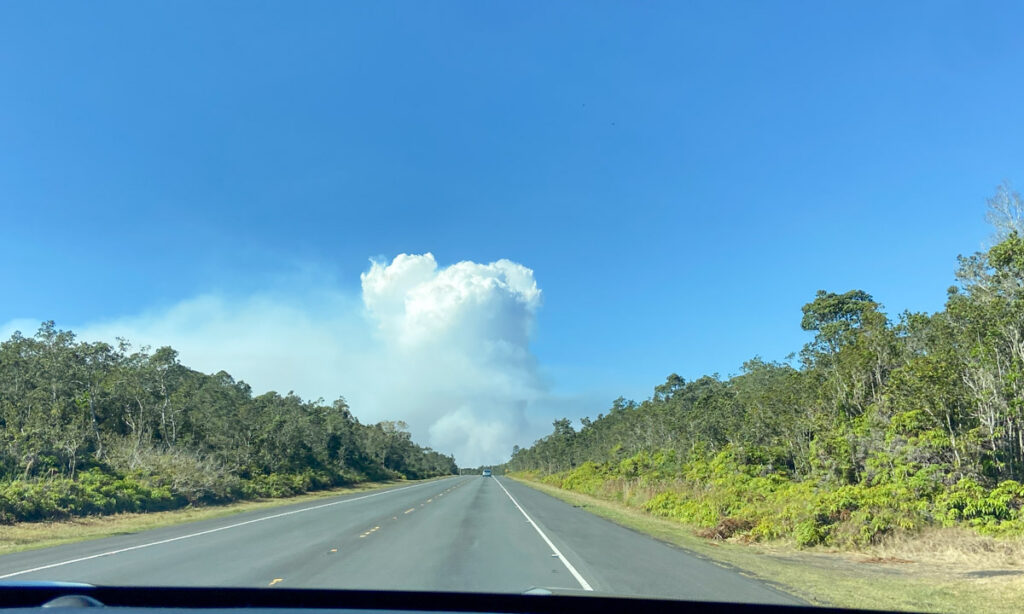
Frequently Asked Questions (FAQ)
1. Is it safe to visit Kīlauea during an eruption?
Yes, as long as you follow National Park Service guidelines and stay within designated viewing areas. Conditions can change quickly, so checking updates before and during your visit is essential.
Pay attention to the park rangers and stay on the trails for safety. The viewing areas are at least 1.5 miles away from the active lava flow.
During the 2018 eruption, conditions deteriorated quickly and rangers worked efficiently to evacuate the park to ensure visitor safety.
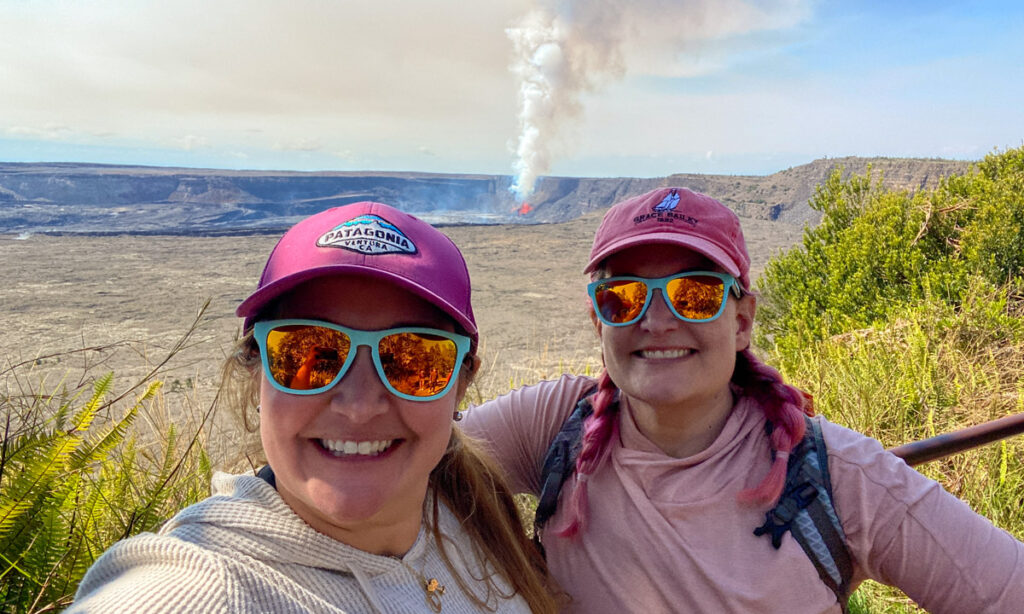
2. Can you see lava flowing at Kīlauea?
Yes, hopefully! That’s why you’re reading this post, right? During our latest visit, there were two active fountains, with lava spewing 150-300 feet in the sky. During my previous visit, there were only small flows through cracks in the lava lake. The best way to check the status of the lava is on the USGS YouTube live stream and their Kīlauea website.
The latest eruption began December 23, and has had nine episodes of eruption over the past few months (as of February 16). Eruptions have lasted between 13 hours and eight days, with periods of downtime between them. Eruptions during this latest episodic series seem to occur after 1-4 days downtime, according to the USGS reports.
Even if the lava is not flowing at Kīlauea, there is still so much to see. I enjoyed my hike across the Kīlauea Iki Trail, across an old lava bed in another crater. There are also series of lava tubes that you can walk through at the Nāhuku Lava Tube trail. Plus, there are numerous other trails that take you through koa and o’hia trees, plus other endemic Hawaiian vegetation that is only found near lava beds.
3. Do I need a guide to visit the eruption site?
No, but guided tours are available for those who want expert insights into the volcano’s history and geology. Many tour companies offer nighttime tours during eruption periods as well.
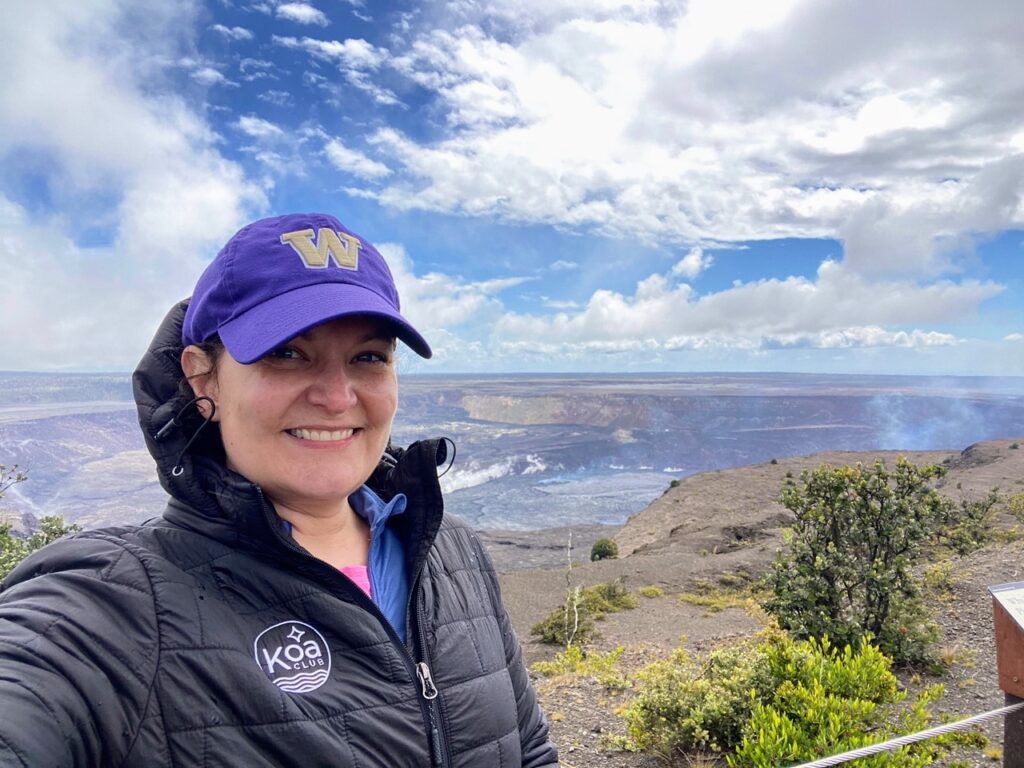
4. When is the best time of year to visit Hawai‘i Volcanoes National Park?
The park is open year-round, but the best time to visit depends on the weather and eruption activity. Winter months (November–March) can be rainier, while summer months (June–September) offer clearer skies. I’ve visited twice in February, once with slight drizzle and once with beautiful blue skies.
Additionally, if you visit during a new moon, the stargazing from both HVNP and Mauna Kea is tremendous.
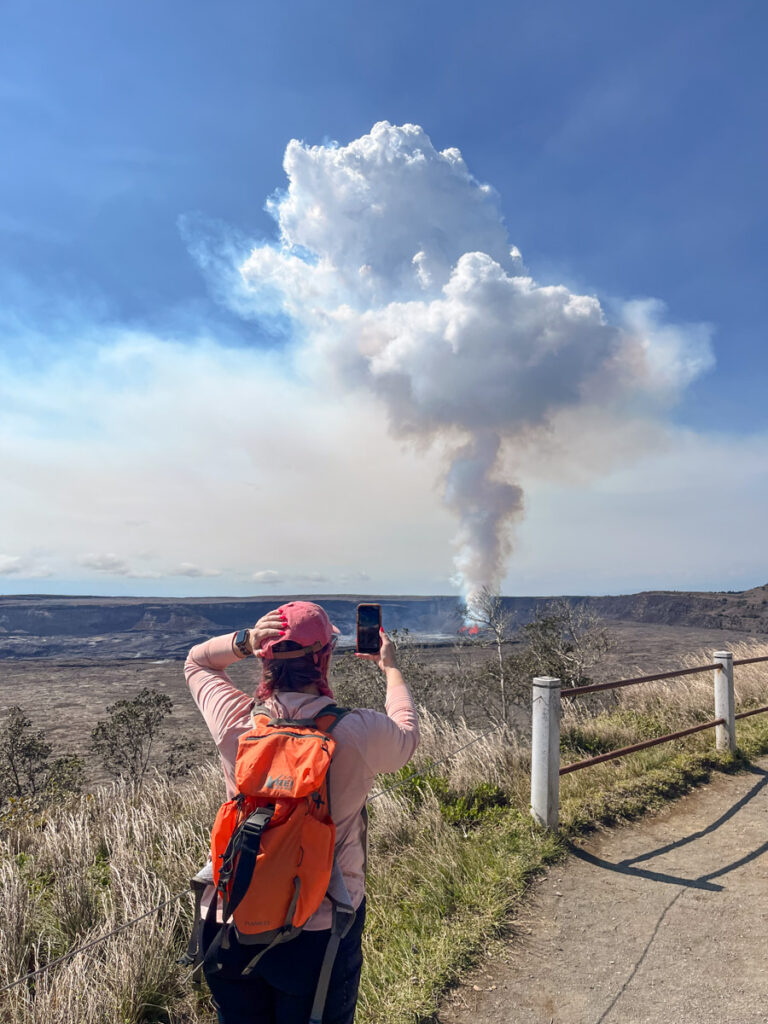
5. What should I bring for a visit to the park?
Comfortable hiking shoes or sneakers, a flashlight (for night time viewing), extra water, snacks, a hat, sunscreen, and a map. Really, you should always be bringing the ten essentials with you.
I’d also highly recommend a pair of binoculars to be able to see the eruption in detail. Several people lent us their nocs, which was truly kind. You really see the power of the eruption this way!
Additionally, I’d recommend a coat and hat. On my first visit, I wore a long sleeved tech shirt and puffer coat, and needed it because of the cooler temps and the wind. On our second trip, we had blue skies and sun so I needed sunscreen instead! Better to be prepared than be cold or wet.
Lastly, you might bring along a book or nature guide to identify what you see on your hikes. Hawai’i has many species unique to the islands. For example, the o’hia tree is one of the first plants to grow directly on lava after it’s hardened because of acid in its roots. Many other books relevant to our national parks are found in my last gift guide.
6. How much time should I allocate to see the Kīlauea eruption?
On both of my visits, I spent about four hours in the park, including a visit to the Visitor Center to get a passport stamp, viewing the eruption from several viewpoints, and hiking or walking the trails. You could certainly spend more time by hiking several of the longer trails within the park.
At a minimum, you need two hours to see this park to park and see the eruption from Volcano House and Steam Vents parking lots. I’d recommend 4-6 hours, if you have the time.
Combine your trip to the national park with lunch and a visit to the famous Black Sand Beach!
7. Do I need a car to visit Hawai’i Volcanoes National Park to see the eruption?
Yes, you do. There is not public transportation to the park or within the park, nor is there any sort of shuttle system. You can rent a car at the Kona International Airport, or at many hotels on the island. If you do not want to drive, there are many guided tours that include Hawaii Volcanoes National Park, although you may have limited time to see the eruption. My sister and I spent about four hours looking at it, attending a park ranger talk, and filling out our Junior Ranger book.
The park is a 2 hour drive from Kona, a 2 hour drive (around the opposite side of the island) from Waikaloa, or 30 minutes from Hilo.
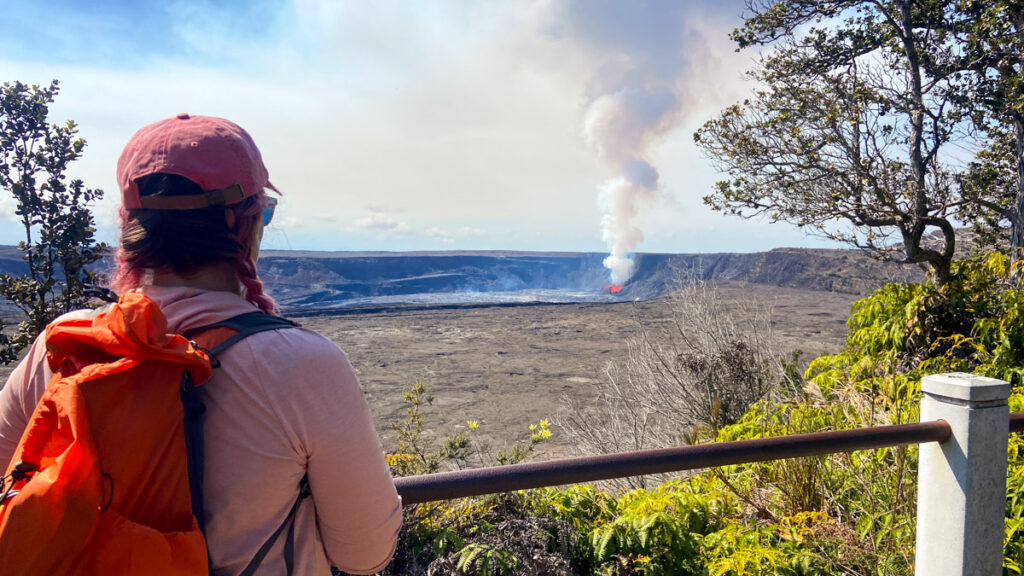
8. How much does it cost to visit the Kīlauea eruption in Hawaii?
Single-entrance to Hawai’i Volcanoes National Park costs $30 per car. An annual pass to HVNP and the two other Hawai’i national park sites, Puʻuhonua o Hōnaunau National Historical Park on Hawai’i and Halēakala on Maui, costs $55. An America the Beautiful Pass, which includes entrance to all national parks, is $80.
9. Where do I stay to visit the Kīlauea eruption in Hawaii?
The closest place to stay is the Volcano House hotel, located in the park across from the Visitor Center. This hotel has rooms that look out directly onto the crater, so you can see the lavaglow at night and be among the first to view it in the morning. (rates from $250)
Volcano, a small town just outside the park:
- Star Gazer – Tiny House: The nice thing about Volcano is that you can find serene retreats in the forest like this one. (rates from $196)
- Romantic, Private Cottage Nestled Away in Volcano: Only 5 minutes away from the park, making a trip to see the lavaglow easy
Hilo, home to the Hilo airport. 30 minute drive:
- Grand Naniloa Hotel Hilo – a Doubletree by Hilton: Hilo is rainier than the other side of the island, which means you’ll have gorgeous views over the water. (rates from $176)
Kona, home to the Kona airport and historic Kona Village. 2 hour drive:
- Courtyard by Marriott King Kamehameha’s Kona Beach Hotel: I’ve stayed here, and being in the middle of historic Kona Village and centrally located to everything else on the island is clutch. (rates from $380)
- Royal Sea Cliff Kona by OUTRIGGER: Outriggers are very family friendly resorts, and this one has a great beach just south of Kona. Some rooms have kitchenettes! (rates from $380)
- Makana Kai Hale: Oceanfront House on Famous Ali’i Drive: Or for just a bit more, stay oceanfront in a house! (rates from $495)
Waikaloa and the northern part of the island. 2 hour drive around the other side of the island:
- Hilton Waikoloa Village: The other hotel in our area of Waikaloa. I’d absolutely stay here again, since the beach was amazing. Has a golf course! (rates from $379)
- Mauna Lani, an Auberge Collection Resort: We ate dinner here and holy smokes was this a beautiful hotel. This is a splurge for sure, but stunning. (rates from $949)
- Mauna Kea – Waiulaula Condo: Honestly there’s no shortage of condos in any of these areas, so if you’re with a family or group of friends you have your pick. (rates from $545)
Conclusion
Experiencing the Hawai‘i Volcano National Park Kīlauea eruption is a once-in-a-lifetime opportunity. By visiting you can witness the incredible power of Pele herself. Stay informed, plan ahead, and enjoy the views of one of the most active volcanoes on Earth!
I acknowledge her majesty Queen Liliʻuokalani yielded the Hawaiian Kingdom under duress in protest to the United States. You can read about this in her own words in “Hawaii’s Story by Hawaii’s Queen” written by Queen Lili’uokalani.

